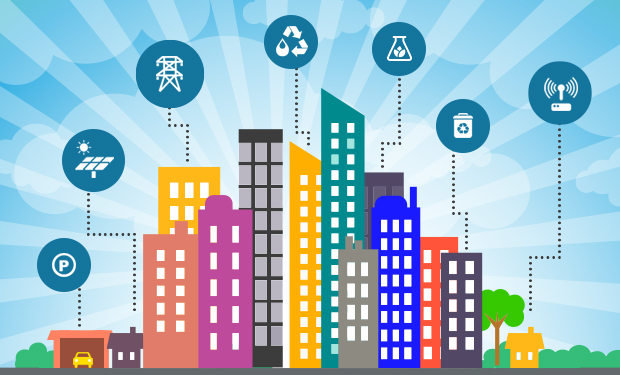Digital India Through Smart Technology
Smart Technology
The Government of India took a bold step by launching Digital India campaign on 1 July 2015. The main motto of this launch was to improve the online infrastructure by increasing internet connectivity and making country digitally empowered with technology.
Digitization refers to the development, operation, and maintenance of the background technological environment including the infrastructure within government organizations. Government’s digital transformation approach aims at improving internal processes, structures, and working practices of government organizations through digital technology. It goes beyond the simple automation and modernization. Realizing this reform and transformation demands a fundamental rethinking of how government organizations operate and of how the current digital and technological environment can be used innovatively to lead to the desired levels of transformation and modernization of government organizations and public services delivery.
Key vision areas of Digital India include:
- Development of secure and stable Digital Infrastructure:
The main aim of the government is to provide fast and high-speed internet connections whose utility will last long. It also focuses on to provide a stable digital infrastructure and easy access to any online services.
- Delivering government services digitally:
Digitally provided services will promote and motivate people adapt to more and more online services and do transactions that are easy, electronic and cashless.
- Universal digital literacy:
Digital empowerment offers an advantage to people to submit all documents online and not by physically going to schools, colleges, and other government organizations.
For making India digitally strong we need to have Smart Technologies. India is blessed with citizens who have immense knowledge and who are also technologically sound. To utilize this knowledge of our experts and create more job opportunities for our citizens, Prime Minister Narendra Modi launched the ‘100 Smart Cities Mission’ on 25 June 2015.
A total of 100 smart cities have been distributed among the States and UTs on the basis of equitable criteria. The formula gives equal importance to both the urban population of the State/UT, and the number of statutory towns in the State/UT. The Smart City proposals of the winning cities offer insights into how citizens, States and ULBs have interpreted this smartness differently. The way Bhubaneswar has been looked at it is quite different from the way Pune has been looked at it. That is why this mission is refreshingly different.
The selected Smart Cities are pulling loose ends together and the challenges involved can’t be disregarded. The concept of Smart City in India is gaining slow traction and thus, the newly-setup SPVs are facing teething issues. Finance remains a lacuna and for this to be addressed they need greater participation from private sectors.
The Smart Cities Mission is planning to implement varying solutions to address their respective problems. Despite sizeable urban investment needs, cities have largely relied on public funds, such as Centre’s budgetary allocations and state government grants for undertaking projects.
Building Blocks of Smart Cities
- IT-enabled Solutions:
The emphasis on technology solutions has stemmed from the increasing demand for smarter urban services by citizens. Today, they seek transparent and efficient municipal services and round-the-clock access to urban services. To facilitate this, Urban Local Bodies (ULBs) are adopting technology solutions for smart education, healthcare, parking, buildings, etc.
- Smart Mobility:
The provision of efficient transport infrastructure is important for a city from both economic and sustainability perspective. Inadequate transport infrastructure and increasing traffic congestion are some of the pain points that make a strong urge for smart mobility.
- Smart Power:
The focus on smart energy revolves around reliable power quality and climate protection. To meet these needs, utilities need to focus on analyzing existing network and planning for modernization of distribution infrastructure. At present, several cities are also installing Supervisory Control and Data Acquisition (SCADA) systems for monitoring real-time power flow.
- Smart Buildings:
Smart Buildings are one of the core infrastructure elements of a Smart City. Houses, offices, airports, railway and bus terminals, including shopping malls, form a large part of a city’s infrastructure and therefore cannot be ignored while setting up a Smart City. Maximum citizens, spend 90% of their time inside buildings. Smart Buildings can go a long way.
- Smart Lighting:
A smart lighting system can serve as an enabler for transiting to a new era of technology. The development of smart lighting systems can facilitate innovations in transportation, utilities, public safety, which will enable various applications to be globally connected, resulting in well-integrated cities.
- Smart Water and Waste Management:
The term ‘Smart Water’ refers to an infrastructure which ensures that water and energy used to transport it is managed effectively. Recognizing the need for modern infrastructure facilities, a number of ULBs have launched projects to deploy IT solutions. The solutions include advanced flow and pressure management systems, smart bins and tracking systems for the better management of infrastructure facilities amongst others.
- Smart Networks:
Communication, data exchange and interconnectivity form the backbone of a Smart City. A Smart City is based on a new communication concept that combines everything from sensors to information networks. It even calls for greater deployment of Information and Communication Technology (ICT) for ensuring effective connections. In addition, Wi-Fi solutions play a vital role in the development and cloud technology is bound to play a big role in storage. Data centers, Cloud services, Control platforms and IoT technologies are taking the lead in integrating smart devices. Various companies are eager to invest in developing applications for IoT in upcoming smart cities.
- Safeguarding your Organization from Internal Threats - September 19, 2018
- What makes Data Security Indispensable? - September 17, 2018
- Arrival of Vignaharta in ESDS - September 17, 2018
